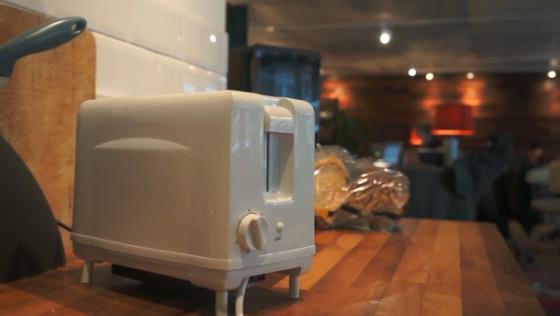When the lonely Theodore Twombly, played by Joaquin Phoenix in Spike Jonze’s sci-fi film Her, enters his Los Angeles apartment, warm lights turn on and fade, following his movements without so much as the touch of a switch.
This is the future of our possessions we’ve been promised by the utilitarian vision of the “Internet of Thing”—services like Nest’s self-adjusting, data-connected thermostat. But as these utilities are able to act increasingly of their own volition, what if we can’t help but give them desires and personalities of their own?
The human instinct to anthropomorphize is a sticky one—see the Twitter account @HouseofCoates, which live-tweets the voices of the utilities and gadgets in the San Francisco home of entrepreneur Tom Coates. Most recent tweet: welcoming its occupant home. And books and films are filled with this idea, from the bumbling robot in Pixar’s Wall-E, to the organic lamppost of the Narnia series, to the singing candelabra Lumiere in Beauty and the Beast.
Dutch designer Bob de Graaf explores the prospect of a utility imbued with a mind of its own with a couple of lamps called Species of Illumination. The lights, Wallace and Darwin, are mostly autonomous creatures, seeking out light and movement.
Wallace is affixed to the ceiling but uses sensors to find the darkest point of the room and moves to light it, before shifting its spotlight to the next dingy corner.
Darwin is a desk lamp on wheels. Each day it seeks out patches of sunlight to power the solar panels on its back. In the evening it looks for movement and trundles to where humans are congregating and where it can be most useful. If you wave a hand in front of Darwin, it follows your hand until you remove it—much like a well-trained puppy.
“I think my lights are very much animate objects,” de Graaf told the U.K.-based design blog We Heart. “At this point I’m still pretty sure they are not alive, but I think there will be a moment where the boundaries become more blurred.”
Watching them move about, it’s impossible not to create a fiction around Wallace and Darwin. They seem inquisitive and eager to please—committed to search endlessly for dark corners to light or squares of sunlight. I almost want to pet the lights, to please them, to even apologize for inconveniencing them.
While de Graaf’s lights are sweet and longing, other smart objects may be petty and jealous.
Brad the toaster is a utility with an unstoppable desire to make grilled bread products; part of a design concept called Addicted Products, by Italian designer Simone Rebaudengo in collaboration with TU Delft/Haque Design Research. It was recently named “Best in Show” at the 2014 Interaction Design Association’s Interaction Awards.
Rebaudengo created a website to accompany Brad and the other four toaster prototypes, connected by Ethernet and sensors. On the site, people could apply to be the host of one of the smart toasters. If his then-owner wasn’t making enough toast, Brad showed his sadness by wiggling his handles. The toasters could also compare themselves with one another—and if Brad was being used less than his brothers, he’d ping a database of potential new toast-eating masters, letting them know he was on the market for a new owner.
Rebaudengo wanted to test far would an addicted product would go to be used. He asked: “What would be its ultimate extreme decision? Stop working? Sell itself? Suicide?”
This independent agency provoked a strong reaction: “Offices organized parties to get more toast done or cheated by making multiple fake toasts in a row. I received frightened emails asking what to do in order not to lose the toasters, offers from people willing to pay to get one over the ocean, offers to pay “premium fee” to keep it, and requests from a lonely Italian grandma,” Rebaudengo told the Interaction Award committee.
In fact, a nagging toaster has been part of the popular imagination before, just like tap dancing light fixtures. The BBC sci-fi comedy Red Dwarf featured a chatty toaster that just wanted people to eat toasted crumpets all the time and was constantly at risk of a meltdown.
Wallace, Darwin, and Brad challenge the idea of the “Internet of Things” as seamless and hyper-efficient. Wallace looks ceaselessly for dark corners, though perhaps not the corner you want lit, and Brad lives to be used, not solely when you are indeed craving toast. In this future, our buying power is not sufficient to cause ownership over those items to which we’ve given the fiction of self. Unless of course, you turn it off.
Will we be able to resist giving our smart things such a narrative? As the Red Dwarf toaster says, “But I’m a toaster, it is my raison d’etre. I toast, therefore I am.”
